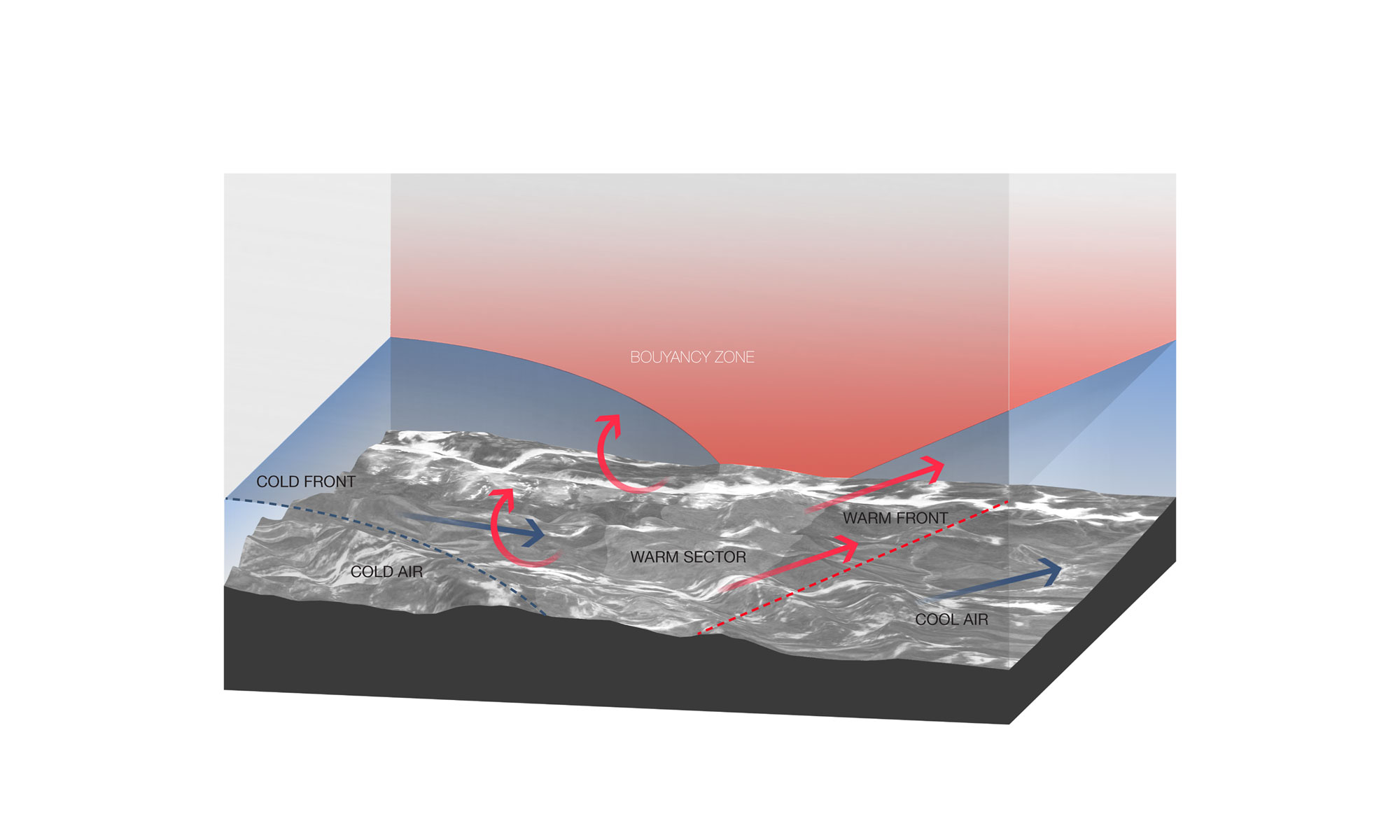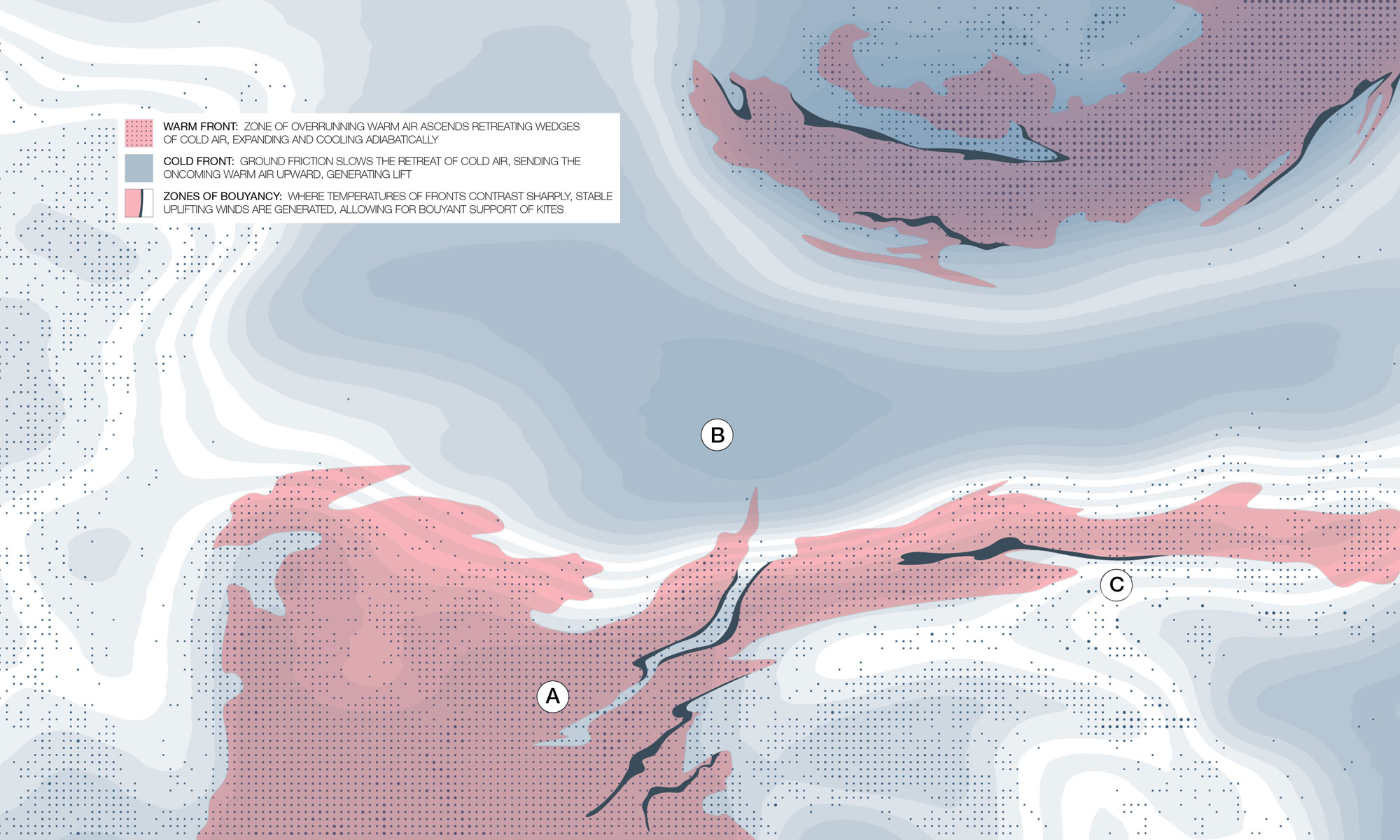
During the 1960’s architects engaged the atmosphere by proposing schemes to inhabit the air. In reaction to the aggressive growth of cities, they responded with mega-structures that delaminated from the earth’s surface, creating new manmade horizontal datums. Projects by Yona Friedman, Superstudio, and Constant’s New Babylon, envisioned an a-geographic metropolis, an urban system that could be extended indefinitely, cloaking the planet in an idealized utopia. Ron Herron’s Walking City introduced a radical portability, underlining the fact that cities, or even nations, are merely cultural constructions, and as such not subject to the limits of a specific geographic place. The city as a socially constructed, power-object was suddenly infused with its own agency, freed to roam about at will. In Japan, the Metabolists’ visions of mega-cities expanded to occupy sea and sky in response to rapid population growth, centralization and lack of available land. Their architecture and cities were envisioned to simulate cycles of natural organisms and metamorphose according to change in social and economic contexts.

Figure 2: occluded frontal wedging occurs when cold dense air displaces warm, less dense air – along their boundary lift is generated to support a single family dwelling attached to an oversize transparent sail
These visions represent the first phase of the colonization of the atmosphere, which found its ultimate expression in Buckminster Fuller’s Cloud Nine project. Fuller envisioned cities as giant geodesic spheres filled with air that when heated by the sun would float among the clouds. Nomadism is implicit in the project, because the atmosphere recognizes no boundaries – the weather above one nation is coupled with the weather above others. Fuller’s proposal is perhaps best understood in the context of the discourse that envisions a collapse of the geographically bound nation-state.

Figure 3: a transparent polyethylene sail skirting the underside of dark mammatus storm clouds which signal a collision of pressure cells
The ascendancy of global capitalist aggression has rendered nations irrelevant. Resources are exploited by capital with disregard for boundaries; the paraphernalia of commodity production are resisted by no sovereignty (with few notable exceptions). Within this hyper-homogenized system, the nation-state is immaterial, in fact one can argue that it is disruptive to the smooth flow of goods. The emergent boundary-less global culture is tied to no place or period. It is atmospheric, context-less, a patchwork of disparate components drawn from everywhere and nowhere, activated by planetary telecommunications systems. Widely diffused in space, a global culture is removed from any past. Existing in an ephemeral present, with a continual pursuit of an imagined future, it has no history. A global culture is here and now and everywhere, its sense of timelessness underscored by the technical nature of its discourse.
Technological extensions, such as buildings, computers and space stations, are continually being elaborated to the degree that they are replacing nature, generating a new cultural dimension. This technological detritus has a profound effect on mankind. Not only are humans as material as the matter they shape, but humans themselves are molded by the matter with which they are surrounded. The nation-state as it exists today will be made obsolete through the modification of our biologically programmed behaviors, which in turn are affected by the very world that we are creating. In controlling our environment, we are determining what we will become.
A possible inference that could be made from the destablilzation of the nation-state might be that contemporary society is becoming rootless: hyper mobile and with an intense connectivity that resembles a hive mind. The increasing velocity of cultural motility suggests the probability that liminality will be expanding. It is understood that during liminal periods social hierarchies might be upset or dissolved, and future modes of habitation, once taken for granted, can be thrown into doubt. An uncertain and malleable stage, liminality allows for new structures to arise from thresholds created by social, climatic or technological pressures. This paper makes the claim that for designers to remain relevant, they must engage not only the solid lithosphere and fluid hydrosphere, but also the vaporous third sphere, the atmosphere, as a medium for intervention.
Imagine an aerial architecture, unmoored from the planets cloddy crust, defying gravity, drifting in a nephological landscape. Nested sets of isobars signify dense agglomerations of dwellings, with increasing atmospheric pressure providing greater support. Air flows outward from a surface high and inward toward a surface low, the boundary between the two creates an energetic zone that can support entire communities, just as the convergence of land and sea nourishes a rich variety of coastal biota. Climatic energy may one day be tamed and harnessed, allowing humanity to escape geography and its inherent violence.


Figure 4: Idealized structure of a midlatitude anticyclonic convergence. Cross section shows movement of cold and warm air masses.
The atmosphere is a fluid whose circulation possesses a highly complex and predictable structure, driven by radiation from the sun. It contains a collection of landmarks consisting of permanent and semi-permanent synoptic features such as convergence zones, jet streams and the major cyclonic and anticyclonic centers. Someday we may be able to harness atmospheric buoyancy on a scale large enough to support humanity in lighter than air communities, abandoning earth’s surface and thereby allowing it to regenerate. The historic trajectory of humanity’s ascendance from caves to reaching the outer limits of the solar system, suggests that it is only a matter of time before the third sphere is occupied.

Figure 5: map view of areas of high and low pressure delineating distinct boundaries between warm and cold fronts. The shaded areas indicate regions where stable updrafts are most likely to occur, potential zones of inhabitation
Type: Speculative
Location: Atmosphere
Completion: December 2012
Principal: Ostap Rudakevych
